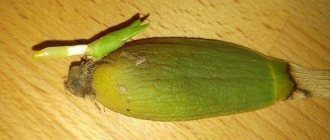Any indoor plants require attention, care, and proper care, and violets need this more than others, since they are very susceptible to external conditions.
If a violet withers, its leaves droop, it means that it doesn’t like something, but finding the reason for this state of the flower is extremely difficult, because there can be many factors.
Still, let's try to figure out what could be the matter if Saintpaulia suddenly shows signs of wilting or illness, and how to restore health to your favorite flower.
Features of violets
In nature, violet grows on poor, loose soil in the shade of tall trees, in conditions of long daylight hours.
This must be taken into account when growing it in an apartment. The lush bloom of an indoor flower pleases only those who respect its natural habits. Violets naturally grow in the shade of trees.
As the violet grows, the lower leaves gradually:
- Turn yellow;
- And they fade.
To maintain the decorative appearance of the plant, they must be removed periodically. But in some cases, the process of leaf wilting gets out of control and affects the entire plant.
In this case it is important:
- Establish the correct reason;
- And try to save the plant.
Care errors
If violet leaves become soft and limp, and the stems curl, then in 90% of cases the reason lies in care errors. Unfortunately, no one is immune from such troubles. Most of these reasons can be easily dealt with if you start fighting to save the flower on time.
Insufficient lighting
Violets require good lighting for full growth and development; they need at least 12-14 hours of daylight. In summer, natural insolation is enough for the plant, but in winter the flower requires additional lighting. Typically, special LED or fluorescent phytolamps are used for this. Experienced gardeners recommend giving preference to the first option, since in this case the air near the flower does not overheat, and much less electrical energy is consumed.
When choosing a suitable model, be sure to take into account the spectrum of the glow; it should be yellow, as close as possible to the sun. However, if you don’t have a special phytolamp, then the most ordinary fluorescent one with white light will do, just try to have it with a lower glow.
Keep in mind that excess lighting also negatively affects the condition of violets - scorching direct sunlight often leads to burns of leaf blades and drying out of the rosette. That is why try to avoid placing the flower on southern windows, and if there are no other options, then be sure to cover the window with tulle or cover the glass with reflective film. If the reason for leaf wilting is related to lighting errors, then you should simply carefully cut off all damaged leaves and create optimal light conditions for the plant.
Irrigation violations
As a rule, violets are buried quite close to the surface when planting, so irrigation should be carried out extremely carefully and delicately. With strong pressure from the water jet, the roots begin to become exposed and dry out, as a result, the plant does not receive enough nutrients, and the leaves begin to fade
Watering should be regular, but moderate. Any waterlogging of the soil has the most detrimental effect on the condition of the flower. In this case, it is necessary to remove the plant from the pot, cut off all the rotten roots and plant it in new soil.
At the same time, violets do not grow or produce flower stalks in an overdried substrate, and the leaves dry out and wither. In this case, it is very easy to fix the problem - you just need to add water to the flower pot. The violet should be watered 2-3 times a week in the summer and once in the cold months.
Incorrect feeding
Everyone knows that a lack of nutrients worsens the condition of a flower, but it should be borne in mind that an excess of mineral components causes them no less harm. The plant is demanding of fertilizers, especially in the spring, when the active growth of green mass begins and the flower is preparing for budding. Usually, after transplantation, the violet is not fertilized for about a month, and the rest of the time, fertilizer is applied twice a month from March to October, and during the dormant period - once every 30 days.
For fertilizing, ready-made complexes specially formulated for violets are used. During the period of bud formation and flowering, preference should be given to preparations without nitrogen. Otherwise, the leaves grow unnaturally, but at the same time become loose. In this state, any violation of the conditions of the flower causes the leaf blades to wither.
If the grower knows that he missed applying fertilizer, he just needs to add it. But when a plant has become a victim of oversaturation with minerals, it can only be saved by replanting it in a fresh substrate with a slightly acidic reaction. To do this, turf soil is mixed with compost and peat or rotted pine needles are added, and a little vermiculite or perlite is added to make it loose.
Air parameters
Violets require maintaining normal room temperature at 18-23 degrees, and the optimal humidity level is 60-70%. At the same time, violets can tolerate slight waterlogging, but dry air is destructive for leaves, so you should not place flowers near a radiator or other heat sources. It would be a good idea to turn on a humidifier or indoor fountain from time to time.
Why does the violet wither?
Violets are very beautiful ornamental plants, but at the same time they are also very capricious. Any disturbance to their habitat can affect the appearance of the flower. They are also susceptible to pests, especially fungi. Let's look at the most common reasons why Saintpaulias may wither.
Lack of light or excess of it
Violets need to receive at least 12 hours of daylight per day. In winter, when the days become short and cloudy, they may lack light. In this case, they must be illuminated with artificial lamps.
An excess of light radiation also negatively affects their well-being. In addition, they do not tolerate the sun's burning rays at all. As soon as the plant stands on the windowsill in the summer, on the south side, after a few days you will notice that the leaves begin to turn yellow and wither.
Save Saintpaulias from withering and dying
How to do this in a more gentle way? It all depends on the degree of damage to the roots.
Most often, if we see that the leaves of a violet wither and die, this means that the fleshy rhizome has begun to deteriorate. At the site of its defeat, a soft, slippery brown rot forms.
1. First you need to cut off the lower soft leaves at the base of the “stem” and inspect it. If the process has gone far, rot is already visible at the cut sites. All that remains is to cut off the healthy top and root it.
2. If there is no external damage, you will have to dig up the entire plant and examine the condition of the root. It happens that the lower part has become completely soft. It is necessary to remove the damaged areas, cutting to healthy tissue with a clean, sharp knife or blade.
We update the cut until greenish tissue without brown appears:
3. Prepare loose soil with an acidic reaction, leave the violet in the air for 10 minutes, dip the cut (optional) in root or crushed coal, and plant.
4. Gently and lightly water along the edge of the pot so that water does not get inside the rosette.
5. To avoid severe loss of moisture, remove the lower leaves in sufficient quantities and place them together with the pot in a plastic bag. Ventilate daily.
It is known that it is easier to prevent trouble than to correct it later
Therefore, it is important to take preventive measures to ensure that the problem of violet leaves does not arise:
- Inspect the plant periodically whenever possible
- Periodically add phytosporin against rot to irrigation water.
- Avoid over-drying and over-watering
- Eliminate drafts
It is visually interesting and detailed about what to do if the leaves of a violet become limp, described in the video:
You may be interested in the following information:
What to do?
If you find limp lower leaves on a plant, try to find the cause. If the room is hot and the soil in the pot is dry, then abundant watering combined with sprinkling can help the violet. At home, the flower is placed in a basin and watered from a shower or watering can with lukewarm water, washing all the leaves. The pot is left in a bowl of water for about 30 minutes.
In order for Saintpaulia to finally get stronger, you only need to keep the soil moist, but if the plant suffers from wilting even after this, the cause can be determined by the signs accompanying undesirable conditions (pests, waterlogging or low temperature). Once the cause is discovered, proceed as follows:
- When the soil is waterlogged and too dense, the root system suffers greatly. In this case, it is recommended to remove the flower from the container, wash off the remaining soil from the roots and inspect them. Having found traces of rot, cut off the damaged parts and dust the sections with activated carbon powder. Transplant the bush into new soil in a small container (even a large Saintpaulia requires a container of about 1 liter).
- If the rotting process has taken over the stem, remove the lower flaccid leaves and cut the rosette down to intact tissue. Healthy pulp has a light, slightly greenish color. It is easy to root the rosette again by deepening the cut into the soil by 2-3 cm.
- If the wilting is caused by pests or diseases and proper care cannot help, the only thing to do if the violet wilts is to purchase a repellent for insects, fungi or infections at the flower shop. Spray the plant with the composition and keep it in a mini-greenhouse from the bag for 12-24 hours.
It is advisable to fertilize with mixtures specially designed for flowering plants, where all elements are balanced. Subject to simple conditions and dosages of the drug, violet will not suffer from an excess or deficiency of minerals.
Violet withers after transplantation
Often after resuscitation, especially if the Saintpaulia had to simply be transplanted, there may be no improvement or the flower’s condition may even begin to deteriorate. These processes are manifested by general lethargy, loss of turgor, and a change in the shade of the leaves. In this case, how to save a violet that is withering?
It is important not to panic and assess the condition of the individual, because it may simply be a slow improvement after an illness, or it may be an incorrect diagnosis and/or incorrect treatment. If the plant is just slowly recovering or there is no improvement at all, you should think about changing the method of resuscitation or just watch and wait
For example, if the rooting of the top is carried out in the ground, it is worth doing this in water. If Saintpaulia becomes worse, it is necessary to urgently inspect all parts of the flower for undetected problems and take measures to improve the condition
If the plant is simply slowly recovering or there is no improvement at all, you should think about changing the method of resuscitation or just watch and wait. For example, if the rooting of the top is carried out in the ground, it is worth doing this in water. If Saintpaulia becomes worse, it is necessary to urgently examine all parts of the flower for any undetected problems and take measures to improve the condition.
If the violet withers after transplantation, check whether your actions are correct.
Wilting can also begin due to improper care. If the reanimated plant is over-watered, then even if this was not the problem initially, the excess moisture will play a negative role in the treatment.
Attention! Having determined why the violet is withering and how to save it, you should immediately begin resuscitation efforts!
Why did the violet leaves become limp and soft?
refers to nonspecific symptoms
To make a diagnosis, you need to carefully examine the plant and try to understand where the mistake was made.
These reasons are universal and are suitable for most cases of leaf wilt, be it:
- Violet leaves wither during flowering;
- Either the upper leaves wither;
- Or the leaves wither in winter.
All these ailments have similar causes, which we will discuss below. But you need to remember that most often the lower leaves of violets wither.
Result of incorrect content
Not all beginners know why violet leaves wither: what to do about it? First on the list of mistakes when caring for violets is lighting. This plant does not like the scorching sun:
- North or east windows are suitable for cultivation;
- If the window is directed to the south, then it is better to place the violet in the corner or depth of the room. Exposure to direct sunlight causes burns and wilting of violet leaves.
Violet leaves wither due to improper care.
Low lighting and short winter days also contribute to leaf wilting, so the flower needs lighting during this period.
It must be remembered that the main reason for leaf wilting is inadequate care of the plant.
Temperature conditions
The wilting of Saintpaulia leaves is promoted by:
- Cultivation at low temperatures;
- Sudden changes in temperature;
- Excessive ventilation of the room in winter.
In conditions of low temperatures, it is necessary to sharply reduce the number of waterings, since a wet earthen ball contributes to hypothermia of the roots.
Excess or lack of soil moisture
The watering regime is very important for good violet growth; the plant should not be over-dried or over-watered:
- In winter, violets are watered once a week. Excess moisture is fraught with rotting of roots and wilting of leaves;
- Stagnation of water in the pan is not allowed after 30 minutes. after watering, drain off excess liquid;
- It is recommended to water only after the top layer of the substrate has completely dried.
In apartments with central heating, air humidity must be maintained at about 50% in winter. Due to poor humidity, the leaves become soft.
Pot size
- Too large a container contributes to waterlogging of the soil, rotting of roots and wilting of leaves;
- In a small pot, the root system is injured due to lack of space;
- The diameter of the pot should be three times smaller than the diameter of the leaf rosette.
The wrong pot may cause violet leaves to wilt.
It is recommended to plant violets in pots with a diameter of 7-10 cm made of plastic or other material that does not dry out the soil.
Top dressing
Often the leaves wither due to lack of nutrients, especially during the spring period of intensive violet growth
But it is also important to avoid excessive fertilizing, which can lead to:
- Root burn;
- And the wilting of the plant.
Soil composition
not optimal soil composition or acidity
- The soil should be loose, structured, with optimal acidity in the range of 6.3-6.7;
- Sometimes the soil for violets is not suitable in its general composition, so it is better to buy a ready-made mixture in the store.
Since the composition of the soil becomes depleted over time and its acidity changes, violets must be replanted annually in fresh soil.
Diseases
There are several diseases that lead to the wilting of foliage in violets - late blight, fusarium and root rot.
Late blight
When infected with late blight, the above-ground part of the plant quickly loses its elasticity, becomes lethargic and becomes covered with rusty spots. What to do if the violet leaves become soft due to such a disease? The scheme of events is as follows:
- cut off all soft leaves;
- take the plant out of the pot, shake off the soil and remove all damaged roots;
On a note! Late blight is a fungal disease that affects not only the upper part of the flower, but also its root system!
- we transplant the surviving part of the Saintpaulia into a new pot, which should be slightly smaller than the previous one;
- lightly spill the soil with Fitosporin.
If the root system has been completely damaged, then you can cut the cutting and try to grow a new plant.
Fusarium
Fusarium is the most dangerous disease for violets. The picture of its manifestation is as follows: first, the rhizome begins to rot, then the petioles of the lower leaves and, finally, the leaf blades themselves. They wither, become watery and then die.
On a note! Unfortunately, with fusarium the plant dies very quickly, especially if it suffers from a deficiency of fertilizers and is kept at a temperature less than +16°C!
So, what to do if one of the violets has soft leaves due to Fusarium infection:
- it is very important to immediately remove the diseased plant away from healthy specimens;
- then we destroy it, along with the soil;
- disinfect the pot in which the diseased Saintpaulia was previously located with a solution of copper sulfate or any available fungicide;
- For prevention, we set up a watering regime and water the violets with Fitosporin once a month.
Root rot
The answer to the question of why violets have soft leaves may well be a disease such as root rot. The main symptoms: dull coloring of the above-ground parts of the plant and its sudden wilting. Moreover, if you remove Saintpaulia from the substrate, you will find that its roots have also softened and acquired a brown color.
On a note! In this case, the rhizome is affected by fungal spores, which multiply very quickly in a humid environment! If the acidity of the soil is low, the infection will dissipate quite quickly!
In order to help the violet, you need to do the following:
- reduce the frequency of watering, but rare portions should be plentiful;
- carry out root treatment of infected specimens with the drug “Fitosporin”;
- if necessary, replace the substrate with one that will not retain moisture for too long.
Why do violet leaves wither, who is to blame and what to do
For example, you noticed that the leaves of the violet became soft, sank down the wall of the pot, and their edges began to bend inward. The plant is losing leaf turgor, but recently it was happy with flowering!
Most likely, leaf wilting is the result of improper care. Whatever they say - pests in the soil, little or much light, a viral disease - the main common cause lies in the well-being of the root system.
Why do the lower leaves of violets wither? - this is only the beginning of a process that starts from the root; if it is not stopped, the upper ones will also wither.
We made mistakes while caring for our charges, which means we must do everything possible for their recovery.
The specific reasons leading to violet root rot are as follows:
- Watering is done in the center of the bush from above
- The soil is too dense, causing water to stagnate when watering.
- A violet stands on a cold windowsill
- Small drainage hole in the pot
- The soil is neutral or alkaline, which promotes the development of root rot.
- Lack of drainage
- Depletion of soil in pots with old violets, alkalization and, as a result, the appearance of fungus on the root
- Root burn with concentrated fertilizer
- The temperature of the content is uncomfortable for the violet, it is below 18 degrees
- Pot too big.
Main reasons
Sometimes you can observe a situation when the lower leaves of violets begin to wither and disappear. Moreover, at a time when the lower leaves become limp and soft, everything may be in order with the upper part of the plant (sometimes Saintpaulia may even bloom). Why is this happening? There may be several reasons why violets disappear:
- various fungal diseases that can enter through the soil or through wounds that form due to mechanical damage;
- harmful insects sucking juices from violets;
- improper care of violets - non-compliance with temperature conditions, excess moisture or even root burns.
When violet leaves wither, you should immediately understand the reasons for this phenomenon, and not wait until the process goes too far.
Symptoms: white coating, leaf flaccid, may curl inward
When there is a great desire to have healthy Saintpaulias in the house, you should study the technology of cultivation and care so as not to harm them with your actions.
Many people are interested in the question: why can leaves curl? In addition to insects, viruses and fungi, other symptoms are present.
- Spots on leaves. They say there is a lot of moisture. Drain the soil. When watering, do not pour on sockets. Keep away from direct sunlight.
- White plaque. Indicates drafts. When you ventilate the room, check how much the air temperature changes. Sharp fluctuations are bad.
- Wilting violets. Cut off the shoot - the brown ring will tell you about the fungus, try to look for healthy shoots, root them. If there is no darkening, she is very sick. To avoid infecting others, throw it away.
- The leaves curl downward, inward. Diagnosis: overflow. Try to revive it: remove the roots from the damp lump, rinse in warm water, place in a small pot.
Do not lead to a painful state, do prevention:
- Bring certified products into your home.
- Inspect when purchasing. If you doubt the health of the purchased product, do not buy it.
- Once you buy it, put it in quarantine (it will take three weeks). Let him get used to it, and when you examine him, make sure he is healthy.
Caring for bright violets is not difficult. The species created by breeders are resistant to damage. It’s not for nothing that they occupy a leading position among indoor species. By following the rules, be sure to make friends with them.
Pests
Parasites, as a rule, live on the green part of the plant and in the root zone - in these places they receive a sufficient amount of moisture, so they can intensively develop and reproduce. The first sign of damage is wilting of the leaves, but if urgent measures are not taken, the flower will die in a short time, so emergency resuscitation is needed
If you notice that the leaves of your violet have wilted, drooped, become loose and darkened, then you should take a closer look at the leaf blades. Usually pests are clearly visible even with the naked eye, and even if the insects themselves are invisible, the damage they have caused is striking - such leaves are usually covered with eaten holes
Most often, violets are attacked by aphids, spider mites, scale insects and root scale insects. Aphids are the easiest to notice - they are quite impressive in size and visually resemble small midges. But it is not so easy to notice mites; they affect both leaves and roots, the violet becomes drooping, and small holes form on the leaves. The scale leaves a sticky coating on the leaf plate, in addition, many dark spots can be noted on the back side. To treat a flower, it is necessary to wash off the insects with a concentrated solution of laundry soap, then replant the flower in new soil and, if necessary, treat it with fungicides approved for use at home.
Pest and disease control
Traditional methods of combating diseases are effective in the initial stages. If the flower is seriously damaged, then fungicides should be used.
In case of root rot, cut off all diseased areas of the root to healthy tissue (it has a purple tint). If the entire root is damaged, the violet must be destroyed. If healthy tissue remains, you should tear off the lower flowers, treat the cut with a fungicide or potassium permanganate solution and place it in water or damp to form healthy roots.
To remove pests, you can wipe the leaves with a soap or alcohol solution. If it doesn’t help, only the chemicals “Aktara” and “Karbofos” will save you.
Why do violet leaves stretch upward?
Varietal feature
There are varieties of violets that do not have a strict rosette, and the leaves grow in different directions. These include trailer violets, which come in bush and hanging varieties. They are distinguished by an elongated stem and several growth points, which are located in the axils between the leaves.
Ampelous senoplias are distinguished by drooping stems, while bush ones form several shoots with leaves growing in different directions, including upwards.
Ampelous violet.
Bush violet.
ATTENTION! The growth of leaves upward is a varietal feature of ampelous, bush Saintpaulias.
Other reasons
Other varieties of indoor Saintpaulias involve the formation of a wide rosette of leaves. When they begin to grow upward, this indicates various errors in care, non-compliance with maintenance conditions or pest infestation.
Next, we will look in detail at the main reasons why violet leaves stretch upward.
Lack of lighting, uneven luminous flux
The main reason is lighting problems:
- when there is a lack of light, the leaves of the plant become smaller and stretch upward, trying to get more light;
- when there is excess lighting, the plant covers the growth point with its leaves, protecting it from burns;
- the flower may lift one half of the rosette if the light hits the plant unevenly. If the lighting is on the left, then the formation of a rosette will occur towards the light source, lifting up the leaves on the right.
Indoor air is too dry
Low room humidity can cause leaves to grow improperly. They grow upward, covering the core with the buds from drying out, creating more humid conditions inside.
Lack of humidity occurs during the heating season or hot summer. In this case, the soil dries out quickly, which can lead to another reason for improper plant growth due to lack of watering.
High air temperature
The optimal temperature for keeping a flower is between +20-24 degrees Celsius. Near heating devices the temperature will be greatly increased. In this case, the leaves will turn yellow, forming brown spots on them.
Violet is very sensitive to ambient temperature.
Another reason may be direct sunlight, then the leaves of the plant may receive thermal burns.
Frequent change of location
Indoor violet is a slow-growing plant. With frequent changes of location, she does not have time to adapt to new conditions and lighting.
Soil depletion
The plant is very demanding on soil nutrition. It needs to be replanted 1-2 times a year, and special complex fertilizers must be applied in a timely manner. One of the reasons for improper leaf growth may be a lack of nitrogen or other microelements.
Pest attack
This is one of the reasons for improper plant growth. In case of severe damage, in addition to improper growth, the leaves will curl and dry out.
The main pests include:
- thrips;
- aphids;
- spider mite.
CAREFULLY! Most often, indoor Saintpaulia is affected by spider mites.
Features of the plant and methods of care
Saintpaulia got its name in honor of the discoverer, who back in 1893 introduced it to the wide attention of professional flower growers and the press. Saintpaulia quickly gained popularity and was in particular demand among breeders. Some of them devoted decades of their lives to developing new varieties.
Today they number tens of thousands of species with the most unimaginable colors. In addition, during the selection process, violets became more hardy and adapted to our climate. She is not too fussy about caring for her. In order for the flower to continue to delight with its blooming, you only need to follow a few rules. However, ignoring them leads to the flower quickly losing its strength, withering and ultimately dying.
Proper care should include the following points:
- Air temperature is within 18–24°C.
- Watering. Regular but moderate. Do not allow the soil to become waterlogged. It is strictly prohibited to allow moisture to come into contact with the surface of the leaves. Water only the soil.
- Location. Saintpaulia is afraid of aggressive direct sunlight, but needs sufficient diffused light. In winter, it may be necessary to artificially extend daylight hours.
- Additional food. For full growth and long-term flowering, the violet should be periodically fed with special products that can be purchased at a flower shop. Superphosphates will enhance flowering, and a small addition of humus and humus will help strengthen the plant as a whole.
It should be remembered that violets need periodic replanting. It is recommended to do this at least once a year, since during this time the soil becomes depleted and ceases to fully nourish the plant.
Adjustment of care rules
If Saintpaulia loses turgor, you should go through all the points to understand why the violet withers in the pot. Violets grow well if:
- Located in a well-lit place, but not exposed to bright sunlight;
- There are no drafts;
- Watering rules are followed, the plant is not flooded with water and does not suffer from drought;
- The violet receives full macro- and microfertilizer;
- The temperature and humidity conditions are maintained at about 65%;
- High-quality soil is selected, which is changed once a year;
- Drainage is used;
- Select a pot of the correct size;
- Preventive measures are taken against diseases and pests.
But in some cases, the measures taken do not lead to the desired result. You can simply transplant the Saintpaulia into another pot, seating the children too.
The reason could lie precisely in the lack of nutrition, humidity, or light, if many daughter rosettes grew around the mother bush.
If the violet continues to wither, it is necessary to remove all the dried leaves, trim the plant at the root and place it in water for new roots to appear. There is hope that this method will revive the violet.
Like any cultivated plant, violet needs care and attention. If the owners often leave, during planting you can arrange a wick system for watering the plants. For this you need a synthetic cord. Operating procedure:
- A cord is placed at the bottom of the pot so that one end of it goes into the drainage hole;
- Light permeable soil is poured and violets are planted;
- Water is poured into a container with a closed lid (for example, a plastic mayonnaise bucket);
- A hole is made in the lid for the cord;
- A pot with a plant is placed on the lid;
- The wick is lowered into water, to which microdoses of fertilizer can be added;
- The wick watering device is ready;
- The water will rise up the cord and provide the violet with nutrition and moisture.
Violets respond well to wick watering.
Prevention
For preventive purposes, to protect violets from diseases and pests, you must follow these steps:
- when buying a new flower, do not place it immediately next to existing flowers, keep it in quarantine for a month in an individual place to avoid diseases;
- when buying blooming violets, it is better to remove the inflorescences, this will reduce the chance of infection with thrips;
- before planting or replanting, it is necessary to disinfect the soil and pot;
- keep the plant at the right temperature, and also provide it with timely watering and fertilization in the correct proportions;
- Carry out a monthly inspection of the flower for the presence of parasites; if any are found, treat it with fungicides or insecticides.
Violet resuscitation
Before saving the violet, you need to find out why the leaves of the plant have become limp. It is not recommended to revive violets without finding out the exact cause. By your actions you can harm the flower. So study the issue carefully and eliminate the cause, not the symptoms. So, what to do if your violet has limp leaves?
We save from diseases
Death of the lower leaves of violets can occur due to a number of diseases. These include late blight and fusarium. Both of these diseases are extremely dangerous for the plant, so if you don’t take timely measures, you can say goodbye to the flower.
With late blight, the leaves become limp and lose their elasticity, in addition, rusty spots appear on them. The reanimated plant should be immediately rid of soft leaves. In addition, since fungal bacteria affect the root system, it is necessary to remove the flower from the pot and remove the damaged roots.
After the surviving part has been removed, transplant the Saintpaulia into a new pot and lightly water it with phytosporin. Select pots for replanting that are slightly smaller than the previous one. If the root system has been completely destroyed, you can cut the cutting and try to grow a new plant from it.
When violets are affected by fusarium, the leaves wither, turn brown and fall off. A characteristic sign of this disease is the darkened roots of the plant. You can try to treat your pet in the same way as for late blight, but you should not have high hopes for the flower’s recovery. In most cases, Saintpaulia will die.
Getting rid of pests
When a violet withers, this may be a consequence of the harmful activities of insect pests that parasitize the plant, sucking out the beneficial substances from it. Naturally, if your pet has been attacked by bugs, this will be the easiest thing to establish. Many of the parasites can be detected by taking a good look at the flower, and if they have managed to multiply, you can even notice them with the naked eye.
Most often, Saintpaulias suffer from attacks by root scale insects, nematodes and thrips, but there are many other insects that pose a danger to your flower garden. They are usually gotten rid of with the help of special preparations – acaricides. But it is worth remembering that they settle mainly in the soil. Therefore, in order to protect the flowers, it is recommended to transplant them into a new pot with a complete replacement of the soil.
Eliminating the consequences of improper care
Despite everything, the most common reason that a plant becomes lethargic is still improper care. What are you doing wrong?
Lack of light. Flowers often disappear due to the fact that they were not provided with enough light. They need it for 12 hours a day, so in winter, when natural light becomes insufficient, it is recommended to replace it with artificial light. Excess light. In this case, the leaves may get sunburned and quickly turn yellow. To restore the flower, you need to put it in a place where it will not be exposed to direct sunlight. Incorrect watering. Excess or lack of moisture is equally harmful to Saintpaulias. Due to excess water, its roots may begin to rot, and in this case it is recommended to remove the flower from the pot, remove the rotten roots and replant it in new soil. If the plant suffers due to lack of water, then you can simply water it (but be careful not to flood the flower)
It is important to water the plant correctly. Some people do it wrong, watering Saintpaulia from above - the water needs to be poured into the pan. Excess or lack of fertilizers
Typically, the plant becomes lethargic due to a lack of potassium or nitrogen. If in this case it will be enough to compensate for the lack of nutrients by applying fertilizing, then with an excess of fertilizers the situation is much more serious. It is necessary to transplant your beauty to a new place, and continue to monitor the amount of feeding. Bad soil. Saintpaulias prefer slightly acidic soil, so if yours is not so, you need to change it by replanting the violets. Poor water quality. Water for irrigation should be settled (at least a day) and warm. Cold tap water causes significant damage to the flower. Failure to comply with temperature conditions. The optimal temperature for Saintpaulia is 18–25 degrees. If it is too low or too high, the flowers begin to fade. Move the Saintpaulia to a warmer (or cooler) place. Do not leave the flower in a draft or near heating appliances. Untimely transplant. Remember to repot your plants once a year, and also replant newly purchased Saintpaulias in new soil.
How to save a plant?
To save a plant, first of all, it is necessary to determine what it is suffering from.
If the leaves wither as a result of waterlogging, in order to save the flower, you must:
- Take it out of the pot and inspect the roots.
- Remove damaged areas of the root system, and rinse the healthy part with water at room temperature.
- Dry and replant in a clean pot with new substrate.
Did you know? In Parma, one of the cities of Italy, perfume is made according to an old recipe from 1870 from Parma violets.
If the problem is a dense or highly acidic substrate, you need to take the following measures:
- Remove the flower from the pot.
- Prepare the soil for replanting from deciduous soil, peat and sand in a ratio of 4:1:1.
- Take a new pot and fill its bottom with pebble drainage.
- Fill halfway with prepared soil.
- Place the violet, straighten its roots and gently sprinkle with soil.
- Compact the soil.
Also, do not over-fertilize the flower, since a large amount of mineral fertilizers will have a bad effect on it. The plant will weaken, its growth and flowering will stop. Another increase in fertilizing can cause burns to the roots. To avoid this, it is necessary to urgently replant the flower.
If a flower is infected with brown or root rot, you must:
- Remove the flower from the pot and inspect its roots - the absence of white roots means that the violet is infected.
- Remove the lower leaves and cut off the root part (if there are brown spots, cut the stem higher; if the stem is completely damaged, the flower must be destroyed).
- If you reach a healthy section of the stem, it will be purple; it needs to be cleared of 1-1.5 cm of lower leaves.
- Treat with fungicide and leave for half an hour.
- When the specified time has passed, place in a substrate of vermiculite, water and soil to allow new roots to form.
- Place a plastic bag over the plant to create a greenhouse effect.
- Move the violet to a cool place and use fluorescent lamps as light.
- When roots form, the flower can be transplanted into a pot.
You will be interested to know how to choose the best fertilizers for violets.
If powdery mildew is present, the following measures should be taken:
- Inspect the violet, remove damaged leaves.
- Treat the soil and leaves with a fungicide (Fundazol or Topaz).
- Place the flower in a warm place and leave until dry.
If the plant is infected with mealybugs, you must:
- Remove dry leaves, as the pest may be hiding in them.
- Conduct a thorough inspection of the flower; if parasites are found, they must be removed and the wounds treated with soapy water.
- Treat the soil with Fitoverm and repeat the procedure in a week.
- Rinse the leaves with warm water for 5 days.
Video: how to deal with mealybugs on violets
To get rid of the nematode, you need to dilute Levamisole in water in a 1:1 ratio. Water the flower with this solution and repeat after a week. You can also place the flower pot in a container of water, the temperature of which is +40°C, since it is at this temperature that the pest dies.










